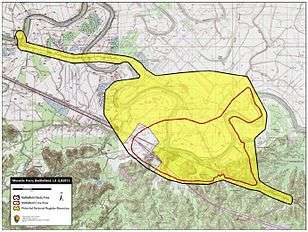Battle of Monett's Ferry
The Battle of Monett's Ferry was fought on April 23, 1864, between Union and Confederate forces in the Red River Campaign. The Union Army was led by Nathaniel P. Banks. They crossed a river to attack Confederate forces, and were victorious, having forced the rebels to retreat.
Background
Near the end of the Red River Expedition, Maj. Gen. Nathaniel P. Banks' army evacuated Grand Ecore in Natchitoches Parish, Louisiana, and retreated to Alexandria, pursued by Confederate forces.
Battle

Banks's advance party, commanded by Brig. Gen. William H. Emory, encountered Brig. Gen. Hamilton P. Bee's cavalry division near Monett's Ferry, or Cane River Crossing, on the morning of April 23. Bee had been ordered to dispute Emory's crossing, and he placed his men so that natural features covered both his flanks. Reluctant to assault the rebels in their strong position, Emory demonstrated in front of the Confederate lines. Among the troops supporting Emory in this effort were members of the 47th Pennsylvania Infantry, the only regiment from the Keystone State to fight in the Union's 1864 Red River Campaign across Louisiana.[1]
Meanwhile, two other Union brigades went in search of another crossing, one of which successfully found a ford, crossed, and attacked the rebels in their flank, forcing Bee to retreat. Banks's men laid pontoon bridges and, by the next day, had all crossed the river.[2]
Aftermath
The Confederates at Monett's Ferry missed an opportunity to destroy or capture Banks's army. According to General Richard Taylor, the errors made by Bee were as follows: Sending Terrell's and Buschel's regiments back to Beasley to guard a wagon train "For the safety of which I had amply provided for", taking no steps to artificially increase the strength of his position, (Presumably by building earthworks or other fortifications), in massing his troops to the center "Where the enemy were certain not to make any decided effort" instead of concentrating on his flanks, and finally, in retreating his entire force 30 miles to Beasley upon being forced back instead of attacking the disorganized Union column.[3] In Hamilton P. Bee's defense, in addition to fatigue on his horses and men from non-stop fighting since the Battle of Mansfield on April 8, 1864 and being outnumbered 10 to 1 and almost out of supplies and ammunition, there was no time to entrench, and Bee wrote that he chose to save his force in order to fight another day rather than see his entire force enveloped and annihilated with an impossible task resulting in the needless loss of irreplaceable troops.[4] Blame for the Confederate tactical and strategic defeat has been debated ever since.
References
- Snyder, Laurie. Red River Campaign (Louisiana, March to May 1864), in 47th Pennsylvania Volunteers: One Civil War Regiment's Story, retrieved online March 31, 2017.
- John D. Winters, The Civil War in Louisiana, Baton Rouge: Louisiana State University Press, 1963, ISBN 0-8071-0834-0, pp. 335, 362
- United States. War Dept, Henry Martyn Lazelle, Leslie J. Perry 'The War of the Rebellion: A Compilation of the Official Records of the Union and Confederate Armies' pg. 580-581
- After action report by Hamilton P. Bee to W. R. Boggs, Chief of Staff, Trans-Mississippi Dept., done on August 17, 1864 at Seguin, Texas in United States. War Dept, Henry Martyn Lazelle, Leslie J. Perry 'The War of the Rebellion: A Compilation of the Official Records of the Union and Confederate Armies' Series I, Volume XXXIV, Part 1, 612-614.[https://babel.hathitrust.org/cgi/pt?id=coo.31924077700288&view=1up&seq=634
![]()